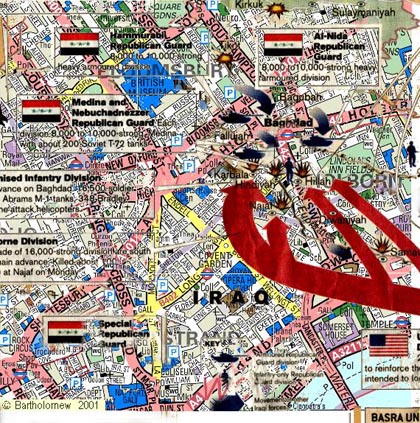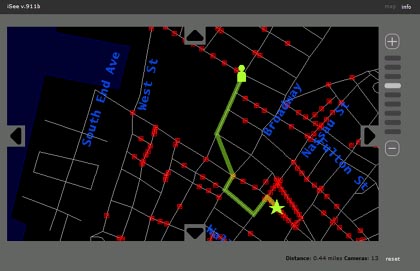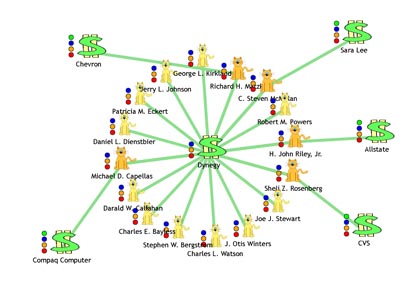Minima Cartographia or The Patient Becomes the Agent
After her active involvement in the recent Cartographic Congress at London’s Limehouse Town Hall, Marina Vishmidt was prompted to consider the problematics of contemporary cartography. With the emergence of collaborative mapping, open data systems, semantic webs and meta-mapping, the function of ‘the map’ in the information age has become as complex as the informatic topographies it rests upon.
 >> Babylondon map, www.anticolony.org.uk
>> Babylondon map, www.anticolony.org.uk
' --- may each point of Heaven be mapp'd, or projected, upon each point of Hell, and vice-versa. And what intercepts the Projection, about mid-way (reckon'd logarithmickally) between? Why this very Earth, and our lives here upon it. We only think we occupy a solid Brick-and-Timber city, --- in reality, we live upon a Map. Perhaps even our lives are but representations of Truer Lives, pursued above and below, as to Philadelphia correspond both a vast Heavenly City, and a crowded niche of Hell, each element of one faithfully mirror'd in the others.' (Thomas Pynchon, Mason & Dixon)
I have seen the future and it is a field of points traversed by lines.
If we are the inequitably witting denizens of an 'information age', bemused by the blandishments of 'visual culture', then the translation of information into visual form, ofttimes called mapping, emerges as the privileged motif and methodology of media, tactical and otherwise. Anaximander may have invented the map in 560 BC, but mapping is hot right now. Look up from your desk, and you will see that everyone is mapping.
Power and counter-power map one another to affirm a semblance of control over the permutations of data that describe the contours of an evacuated political field, mined by entropic information systems. The positionality of mapping counts: as a tool of the powerful to gain purchase on bodies or terrain (military mapping, genetic mapping, consumer tracking, urban planning, representations of space, strategic); mapping as tool by the weak to consolidate their knowledge base of power networks, to spatialise the systematicity of the networks and of their maps (representational space, tactics). Mapping is thereby also the voguish episteme in activist and software-based art, imbued with the conceptualist legacy, itself stemming from the modernist strand that provoked engagement with signifying systems and situated knowledge.
Where mapping was once the province of soporific specialisation, now (and at least since Borges) mapping has dispersed into a million exciting idiosyncratic determinants: subjective, cognitive, semantic, collaborative, repurposed from the purpose-built cartographic habitats of engineering, neurology, surveillance, cybernetics, ecology, military. Mapping is a concept that has been elasticised formally as well as ideologically, happy to encompass diagram-making, model-building, in fact any initiative that generates an objectively legible transfer of a subjective ordering. It delivers a parasitic riposte to the rationalities of control – using the tools as common property of whoever knows how to use them, mapping anatomises the spuriously random fabric of consensual social reality into sets of points that disclose their logic through visual relation, whether as map qua map or as software protocol. A technically-minded suborning of technocratic power in its predilection for consumer/military technologies like GPS and SMS that can pinpoint buyers and soft corporate targets alike.
 >> iSee v.911, a web-based application for finding ‘paths of least surveillance’, Institute of Applied Autonomy
>> iSee v.911, a web-based application for finding ‘paths of least surveillance’, Institute of Applied Autonomy
The great thing about maps is that they are an activity, a record of an activity, and a template to precipitate new activity. Ephemeral-minded projects getting to grips with always-mediated social facts. The socialisation of obsession, even if counter-academy, an inscription/de-encrypting of obsession into discourse which can be empowering in a way that suggest R.D. Laing's description of psychotherapy as a way of recognising passively undergone processes and converting them into praxes – 'the patient becomes an agent.' Here lies also a subtle paradox intrinsic to mapmaking – the research, the investigation, the drawing, finding of an aesthetic, can somehow be more pleasurable and edifying than the result. A finished map can be bewildering, complex and close-woven, though by definition a map is never really finished. An open-ended process has gelled with a stricken look on its face. What was an investigation now looks more like a conspiracy theory.
This symbolism may indeed suffice as long as it is strictly limited to the facts which have served to invent it: but each new fact will force us to complicate our diagram, to insert new stations along the line of the movement; yet all these stations laid side by side will never be able to reconstitute the movement itself.
[Bergson, Matter and Memory, Zone Books, p123]
But the process of mapping, the experience of immersion in discursive area, information, and other maps, is the efficacy of mapping, or any diagrammatic idiom. But how can large quantities of specialised information be presented except in a map? And how can a map remain subjective and conclusive at once and why is that important? Such a double articulation has everything to do with conceptual art turned activist, a formation that's always seen the irruptive potential in irrational epistemology, and whose rather more quiescent potential as cultural capital has never been effulged as widely as it is now.
So how far can we get with ontologies of mapping? What qualifies as a map? Is the definition only a matter of application, is it as fluid as any context-bound item of scholastic taxonomy? How is a map different from an anagram, for instance – both are subjective orderings of information. Is the criteria a suspended 'truth' function, or even a ratio of use to beauty? The permutative aspect of cartography as a world-depicting gesture, its co-articulation of system and singularity, is what both exposes it to and repels the assignation of a truth function, because the gesture of making-world is a priori contingent, yet must call on a set of shared meanings for any kind of communicative efficacy. The possibility of communication can be the danger of authority, or the pre-emption of it, but in any case the production of maps, like the production of any form of knowledge, implies a referent that is external to some degree.
Yet the possibility of signifier and referent coinciding is an adaptive feature shared by epistemologies of contestation and techniques of control, whether developed reciprocally, responsively or relationally to analogous tendencies in art and information theory influential for several decades now. As an adaptive feature, it can augment the capacities of critical mapmaking, turning the focus on itself and its hermeneutic devices, evoking the self-regulative function of the network model. This flexibility then seems to address the gap between map and territory by articulating the gap itself as a mode of enquiry, a mode of relating to the world, the alchemical topography of an incessantly-receding horizon of the real that maps itself mapping. Whether the gap is effectively collapsed or temporarily elided, and to what end, remains an unshakeable aporia in each case. This leads to further questions about the formats and contexts of the cartographic mode, to audiences and users. There are constitutive differences between a map that circulates as an online wiki in an environmental newsgroup, and a map presented in a Vennice Biennale pavilion (even if they are the identical map, both accessible through a browser – objecthood is less and less the definitive split). Inter-operability is just one of the answers. Displacement between contexts can result in volatility, or in enervating relativism with a patina of subversion akin to institutional critique. Hot discursive property that it is, the map is here, there and elsewhere, mining a generous seme.
The map-making impulse seems to epitomise social technology/tactical media mutatis mutandis – it is information, whether or not collectively generated, that can be collected by anybody and made available to all (in practice, along a sliding scale of time, money and devotion). It can be used as the counter-ideological tool nonpareil to systematically visualise power structures – rather than produce a rhetoric of radical oppositionality – implosively using the selfsame tools and isomorphic codes of the interfaces they mimic or disrupt.
 >> foafCORP, a semantic web visualisation of the interconnectedness of corporate America
>> foafCORP, a semantic web visualisation of the interconnectedness of corporate America
The Mapping Contemporary Capitalism project at the Cartographic Congress was a six-day planning session held in the first week of June. It anticipated what a collaboratively-wrought synthesis of semantic mapping concepts and technologies with existing 'power map' formations on the net might start to look like. Utilising open-source protocols and distributed data-sharing, the projected software was hoped to enact both a mimetic and contestatory relation to the data systems of the capitalists it would help keep tabs on. The materiality of information would act as stool-pigeon for the material reality of exploitation. And as maps are increasingly concerned with plotting materiality, they chart along the transition curve from maps of the earth to meta-maps (not that any map can eschew functioning on the meta level for somebody sometime). In other words, maps have de-industrialised as surely as property relations, their arch now more the vector than the poles. To focus on the materiality of information, the constructedness of code, as a critical strategy is by now a much-validated truism in software art and media politics – by interacting with the tools, you can de-mystify the appearances they help to prepare, and, implicitly, the power structures that rely on these appearances. It accentuates how information is just as much a crude substance to be reified or distributed freely as any other good whose circulation information mediates.
As an anti-reification gesture in mapping, though, invoking materiality through spatialising isn't enough: we need more foam contour maps of the internet, more modelling clay depictions of the solar system qua grade-school Science Fair; more perceptual diagrams where emotions are represented by coloured balls, even. This is also the sentiment of Marcus Lutyens, whose presentation at the Cartographic Congress, May 25, drew on 3D modelling technology adapted for simulations and game environments to project the responses of Italian architecture students to their experience of being hypnotised by Marcus Lutyens. Taking an approach conceivably derived from the popular science axiom, ‘In space, no one can hear you scream,’ the user could manoeuvre through a fluctuant grid of axes punctuated with coloured balls ready to explode on impact with the cursor and reveal each hypnotee’s notes, drawings, fears and hopes on the occasion of encounter with the software-happy alienist. The purpose of the séance itself, to get the subjects to re-imagine their relationship to space (something only possible for architecture students in an altered state?), was quickly retrieved and slotted into questionnaires asking the respondents to view their experience through some very loaded, if unavowed Jungian schemata.
The results dictated the placement of the soul-balls in virtual space. Here the signifier and referent were collapsed, if inadvertently. However, it was possible to view the whole exercise as a provocative conflation of net art with hypnotism. It could also have been a slightly more pedestrian amalgam of pop psychology and net art futurama where the an/aestheticising efficacy of tracking a process like cognition through a cognitive process like computer programming results in a graphic interface technically more ornate than the Microsoft Search dog (or at least more interactive), but no more critical of its assumptions, and no closer to unveiling the chaotic materiality that enables the lustrous Amusements of emotional programming.
Cartographic Congress // May 6 - June 15 2003 // http://twenteenthcentury.com/uo/index.php/CartographicCongress // University of Openness, Limehouse Town Hall, London //
Mute Books Orders
For Mute Books distribution contact Anagram Books
contact@anagrambooks.com
For online purchases visit anagrambooks.com






